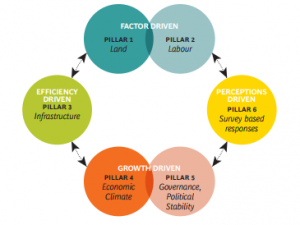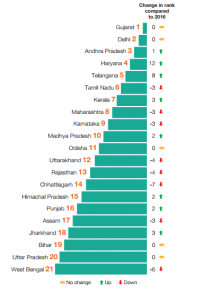
Picture Courtesy: Make in India, Government of India / Representation Only
India is registering a sustained economic growth where the Union Government kick started a set of policy reforms to spur growth further. With increasing economic might of India at the global level, the GDP growth, FDI and the Ease of Doing Business have crept into the common parlance. Equipped new tools, policy makers and researchers came with new economic indicators. In this backdrop, the National Council of Applied Economic Research, NCAER, released the NCAER State Investment Potential Index (N-SIPI 2017).
N-SIPI 2017 covered 20 States and the Delhi Union Territory. It is the second edition that ranks states’ on their competitiveness in business and their investment climate. As in 2016, Gujarat and Delhi again top the list of states, while Haryana and Telangana have moved rapidly up the ranks to finish among the top five.
The Six Pillar of N-SIPI 2017

Source: The NCAER State Investment Potential Index (N-SIPI 2017)
The key findings of the 2017 N-SIPI show that Gujarat, Delhi, Andhra Pradesh, Haryana, Telangana and Tamil Nadu are the top six states for business investment potential. At a greater level of detail, Gujarat also tops the rankings for the 4th N-SIPI pillar on the economic climate and the 6th pillar on perceptions. Delhi is second overall and tops the ranking on infrastructure but loses out on governance and political stability. Compared to 2016, Haryana and Telangana have made the most rapid gains moving up 12 and 8 spots to finish among the top five states in terms of their investment potential.
Although Bihar, Uttar Pradesh and West Bengal are ranked among the least favourable states for investment, they rank higher under individual pillars, with Bihar doing better on the labour pillar, Uttar Pradesh on the land pillar, and West Bengal on the economic climate pillar. Odisha maintains its rank from last year at the 11th position. On the infrastructure pillar, Maharashtra, Karnataka and Odisha moved closer to the frontier, while Uttarakhand and Assam moved further away. West Bengal made the most gains on the economic climate and governance pillars, while Telangana, Punjab, Haryana and Kerala made significant gains under the perceptions pillar.
During the launch, Ramesh Abhishek, Secretary, Department of Industrial Policy and Promotion(DIPP), complimented NCAER for its perceptive and insightful study on the investment potential of India’s states. He said, “The Government takes studies like the NCAER State Investment Potential Index and its findings very seriously and are using the procedural and perceptions-related parameters in both N-SIPI 2016 and this second edition in 2017 for informed policymaking. We are glad to say that the states are also supporting us in our endeavour to improve the business climate across the country.”
Shedining light on the investment opportunities in India, Dr Shekhar Shah, Director-General, NCAER stated, “Investment opportunities are expanding in India in all sectors. The GST will weave India’s states together in ways that have not been possible before. Now, more than ever, there is a need to provide a systematic and reliable “go-to” reference focusing on India’s states for potential domestic and overseas investors. N-SIPI 2017, NCAER’s second edition in the annual series of states’ rankings, is an evidence-based index that will help build continuity, consistency and rigour in ranking investment targets for investors. As importantly, it will help state policymakers measure their state’s performance against that of others.
State-wise Ranking under N-SIPI -2017

Source: The NCAER State Investment Potential Index (N-SIPI 2017)
Dr Shekhar Shah, Director-General, NCAER stated, “Investment opportunities are expanding in India in all sectors. The GST will weave India’s states together in ways that have not been possible before. Now, more than ever, there is a need to provide a systematic and reliable “go-to” reference focusing on India’s states for potential domestic and overseas investors. N-SIPI 2017, NCAER’s second edition in the annual series of states’ rankings, is an evidence-based index that will help build continuity, consistency and rigour in ranking investment targets for investors. As importantly, it will help state policymakers measure their state’s performance against that of others.
Building on the success of N-SIPI 2016, N-SIPI 2017 ranks the competitiveness of Indian states on six pillars: land, labour, infrastructure, economic climate, political stability and governance, and business perceptions. These six pillars are classified under four broad categories: factor driven (land and labour), efficiency driven (infrastructure), growth driven (economic climate and political stability and governance), and perceptions driven (ranking of business climate built on firm surveys). A unique feature of the N-SIPI index is the integration of industry perceptions of the investment potential and business climate of a state along with the fundamentals likely to drive investment decisions in that state. Another unique feature of the 2017 N-SIPI is the explicit inclusion of the land pillar, data for which were not available in time for inclusion in the 2016 N-SIPI.
In this backdrop, the biggest challenge is a sluggish growth in the employment generation despite a host of new policies and schemes.


















